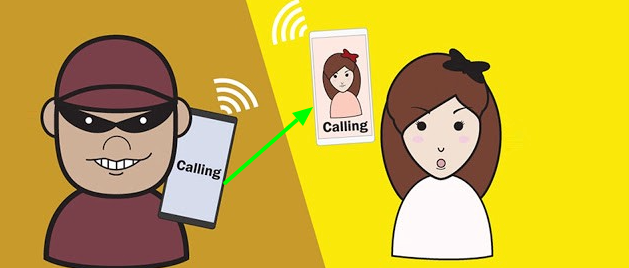How to Detect Fake Calls/Spoof Calls used for Online Scams & Abuse

When we contact people in real life, our face and voice are our primary identity. We can also reveal our name, occupation, and other personal background information. All these are the components of our identity in everyday living. This is how people identify us or know who we are. In the real world, our identity is obvious or directly exposed to the people we interact with.
But when we use telecommunication services like phones and the internet, our identity goes behind a technological layer. It becomes harder to tell who the person is on a phone call or online messaging. While this added layer can serve to provide us with privacy, safety, and protection, people can also misuse it.
"Spoofing" is the act of hiding one's real identity or disguising one's identity to appear as someone else using technology. Spoofing can occur with any medium of communication such as email, phone numbers, websites, social media accounts etc. It can also occur with any technical means of identity such as DNS, IP address, MAC address etc.
In this article, we focus on "caller ID spoofing", in which a person's name and number can be made to appear different. We discuss how one can identify when spoofing is occurring and how to prevent or protect oneself from such incidents.
Why is caller ID spoofing done?
There are 3 main common cases of caller ID spoofing.
1. Legitimate usage of spoofing
In this, busy professionals who commonly interact with many people daily wish to hide their real phone numbers. So, they may use services that provide "fake" numbers that they can share with a larger audience. This allows them to have normal communication in their personal life using their real number, and get more control over how to manage their professional communication. This can be used at a customer service center. The next one is abusive in nature.
2. Scammers who carry out online or phone fraud
Here scammers can use spoofing to appear as authorized or official employees of some organization and call from the officially listed numbers. It's impersonation using 'Spoof Number'.
3. In one's personal life, abusive partners or stalkers can also use spoofing to harass someone
Here spoofing plays a very critical role in domestic violence/stalking. It can be used for kidnapping/threats or any kind of harmful acts from scammers.
We will go through various ways of protecting oneself from such abusive implementations of spoofing. And also see the different methods by which the victims of such fraud or abuse can collect evidence to prove that spoofing has been done to carry out a crime against them.
How to protect oneself from spoofing and related abuse?
Being alert and informed is the number one protective tool. Understand that being exposed to spoof calls by itself isn't directly harmful if you are careful regarding how you handle those interactions and what information you give out. This is especially true in cases of scammers perpetrating phone call fraud to get your banking information or other important personal data.
However, if you are being targeted frequently using spoofing, such as in the cases of domestic violence or stalking, this unsolicited and unwelcome communication itself can cause mental harassment. In this case, you might need to change your phone number and get a court order for the abuser to cease contact.
Here are some key steps to remember to protect yourself or someone close to you from spoofing and related abuse:
1. For critical information related to banking or other personal services, always ensure that you are initiating contact. If you get a call from a number, and they ask you this information or questions related to it, do not answer. In case this was a genuine request, you can call back on a verified number to provide those details.
2. Do not panic. Scammers or abusers can dramatize an emergency or put emotional pressure on you to let you lower your defenses and provide information in the confusion. Always keep your presence in mind, and understand that if you are unsure if the caller is genuine or not, you do not need to reply or provide any information.
3. Get help from your trusted people. Being a victim of spoofing and related attacks can be emotionally taxing. You don't have to face this alone. Gathering support from loved ones will boost your spirit and give you the strength and wisdom to respond properly to the situation.
4. Educate yourself about the various services and tactics used for spoofing. Having this awareness will provide you with the clues to detect and discern spoofed calls from real ones.
5. Maybe you are getting calls repeatedly from spoofed numbers. Even after blocking the abusers' numbers, you keep getting calls from new numbers. Then, it is best to deactivate or stop using your current phone number. Change your number and give it out very carefully to the most trusted people only. Keep the old number SIM card around in case you need it later for your personal use or for help in gathering evidence.
6. Contact the police, lawyers, or the court to seek their protection and legal advice. This is especially important in cases where a financial scam or personal abuse has occurred.
7. In extreme cases, providing a formal and legal threat to the abuser can put an end to their abuse. Seek a court order that specifically prevents the abuser from contacting the victim in any manner. Issue this order to the abuser through the lawyers.
How to detect spoof calls?
Prima facie, the spoofing tactic is designed to be hard to detect. If you get a call, and the caller ID shows a particular number, it is a very common and innocent occurrence. All genuine calls occur in this manner. When you get a call, you don't know whether it is coming from a real number, or through a spoofing service. So, the first order of defense is to be alert about what information you are providing to the person on the other end. When you don't reveal any personal or private information to scammers/abusers in the first place, then their spoofing attack has failed.
Never trust a 'suspicious call' coming from legit/saved number of someone. It may be a spoof call. Disconnect that call and try to call back real person to undersand reality of that suspicious call.
However, let's say you are under a serious form of attack using spoofing. Then it becomes crucial to be able to detect spoofing. You will also need to collect evidence of spoofing and document it properly.
How to detect call spoofing and collect evidence of spoofing:
1. Boost your general knowledge about spoofing apps and services. Spoofing tools can be in the form of mobile apps, web-based services, or phone number forwarding services. Here are some well-known apps or services:
-
- My Phone Robot
- BluffMyCall
- SpoofCard
- Google Voice
- Telzio
- Voiceably
- Covert Calling
2. In the case of personal abuse using spoofing, it is possible that you saw the abuser use any particular spoofing tool. If so, you can seek legal help to request evidence from that service. By correlating the abuser's use of spoofing service with the times when you got spoof calls, you can prove that the abuser employed the spoofing service. Country specifics laws and privacy acts may cause hurdles to getting that data.
3. In cases of scams or fraud, where you do not know the perpetrators, it is best to provide your own call logs to the police or legal counsel. This can help them in pursuing further investigations. They can contact your phone service provider regarding this as well, to identify spoofing calls.
4. Intuitively, you might be able to identify certain patterns in the way you experienced spoofed calls. It might be the case that you were getting calls at a particular time. Or the person on the other end is sounding different because of voice-change features, but the content of their conversation can be familiar. This kind of circumstantial evidence can help in tracking down spoofing abuse.
5. The biggest source of evidence in spoofing attacks, is the source itself: the scammer or the abuser.
Their phone calls logs, browsing history, purchase history, and other movements hold the clues to their actions. Typically, this kind of tracking can be done by authorized law enforcement officials. However, by seeking their help at the right time and assisting them in their investigations, you can expedite the case-solving process.
6. Track call spoofing abuser using WhatsApp with help of the WhatsApp scam tracking method :
In this case, you can engage in a discussion with the abuser and insist him/her use WhatsApp, then you can use our earlier discussed WhatsApp scammer tracking method to know the location of the abuser.
What are the difficulties to detect Spoof Call Tracking?
Irrespective of doing all the above tracking methods, your spoof call tracking may lead to a dead end because of certain technological and geo-political hurdles. That's why the most government is failing to STOP scammers.
1. Use of Proxies/VPN: If a scammer is using proxies or VPN to initiate their scamming agenda then it will be very difficult to get all required server logs using local law and order. Most VPN servers are heterogeneously distributed across the globe & have no log policies.
2. International Borders Security & Law and Orders: If your local law and order authorities identify the location of the scammer and that location is somewhere in another country then it will require a proper international channel like ITU to get data logs to identify that scammer. This required strong international connections between countries along with court orders/subpoenas. No country will be able to share such data without a high-level handshake because of privacy laws & border security.
Summary
Caller ID spoofing hides or changes one's identity in terms of the phone number and name shown. While there are legitimate uses for using fake numbers or hiding one's personal number, spoofing has nefarious usages too. In this article, we discussed the important points to remember so that one can protect oneself and others from spoofing attacks. Being alert and having the presence of mind to reveal personal information only to verified people is crucial.
Having general purpose awareness of spoofing techniques and tools also equips you from planning your moves against spoofing attacks. In many instances such as financial fraud or personal abuse, taking legal recourse is the best option, as law enforcement officials have the powers to collect evidence on your behalf and provide you with the requisite protection. We hope that this discussion of caller ID spoofing has shed some light on the effective tactics to maintain your privacy and security as you navigate the world.




